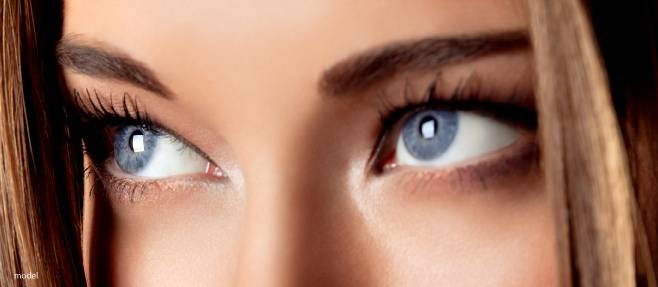Non-Surgical Alternatives to Eyelid Surgery

Eyelid surgery, also known as blepharoplasty, is a surgical procedure that addresses droopy upper eyelids or baggy circles underneath the eyes. While surgery is able to address even the most severe aging symptoms and provides dramatic, long-lasting results, surgery may not be the best option for everyone. In fact, many individuals with light to moderate signs of eye-area aging can benefit from a non-surgical alternative to eyelid surgery.
What is Eyelid Surgery?
There are two primary types of blepharoplasty procedures. Upper blepharoplasty addresses drooping eyelids and sagging skin and muscle tissue above the eye. Lower blepharoplasty treats loose skin and unwanted pockets of fat below the eye. Both types of eyelid surgery require anesthesia, incisions, and significant recovery time.
Understandably, not everyone feels ready to treat the signs of aging with a surgical procedure. Thankfully, there are ways to address sagging eyelids and baggy, under eye circles that don’t require going under the knife. Keep reading to learn more about these non-surgical alternatives.
Non-Surgery Alternatives to Blepharoplasty
Botox
Botox is a neurotoxin that smooths skin and prevents wrinkles by temporarily paralyzing muscle. A Botox brow lift, or Botox eye lift, is an alternative to eye-lid surgery. Injecting this natural neurotoxin above the eyebrows can lift the brows, resulting in less upper eyelid droop. Botox may also help eliminate skin folds that result from crow’s feet and wrinkles around the eyes.
Botox injections take place during a quick office visit and require no downtime. Botox is most effective as a preventative, so it works best for mild cases. Results are not permanent. Regular appointments are necessary to maintain results.
Dermal Fillers
Dermal fillers are used to replace lost volume, and can help reshape skin’s surface. Around the eyes, fillers are effective for erasing under-eye lines, dark circles and hollows. They can also help treat crow’s feet and other wrinkles around the eyes. Botox and dermal fillers are often used in combination to achieve the best possible results.
Fillers can offer immediate results, but these results are not permanent. Regular touch-ups are necessary. Also, not all brands of filler are safe to use around the eyes. Always work with a skilled, board-certified injector.
Genius RF Microneedling
Radiofrequency microneedling is a skin resurfacing treatment that can make the skin around the eyes appear smoother, tighter and younger. After applying a numbing topical, the RF microneedling device creates tiny micro-punctures which prompt skin cell turnover, healing and rejuvenation. The treatment can be customized, so it’s safe for the thin skin around the upper and lower eyes.
Because it encourages collagen and elastin production, results from RF microneedling will continue to improve weeks and even months after treatment.
PRP Injections
Platelet-Rich-Plasma therapy is often used in combination with microneedling. PRP injections are made from the patient’s own blood. First, a centrifuge machine is used to separate out the body’s own rejuvenating blood cells. Then, these healing blood cells are massaged back into the skin after tiny punctures have been created using microneedling.
PRP therapy promotes collagen and elastin production and stimulates the body’s natural healing response for smoother, tighter skin.
Laser Skin Resurfacing
Laser skin resurfacing also leaves skin smoother, tighter and more evenly toned. It’s especially effective to help reverse the signs of sun damage, which may include discoloration, fine lines and wrinkles. Ablative lasers are more appropriate for treating deeper skin concerns, while non-ablative lasers boost collagen production and skin cell turnover.
Laser skin resurfacing may require several sessions before the best possible results are achieved. The procedure works best on those who need only minor skin tightening.
Thermage
Thermage is a skin resurfacing treatment that uses radiofrequency to smooth and tighten skin. The non-invasive procedure is safe enough to be applied around the eyes. During a Thermage treatment, radio waves target the deep layers of the skin to stimulate collagen production, resulting in a smoother, tighter appearance.
Results may be visible after the first treatment, although multiple treatments are often suggested for maximum benefit. Unlike laser treatments, Thermage is appropriate for all skin tones.
Ultherapy
Ultherapy is a minimally invasive treatment that delivers ultrasound energy below the skin surface to target specific layers of the skin to stimulate new collagen. It is a safe and efficacious treatment to tighten skin of the upper and lower eyelids. It has no downtime due to the ability to bypass the top layer of the skin. It can be used on all skin types.
The Pros and Cons of Non-Surgical Eye-Lift Alternatives
There are very good reasons someone might opt for a non-surgical alternative to eyelid surgery. Some of the most common include:
- Less up-front cost
- No general anesthesia needed
- Little to no required recovery time
However, there are some disadvantages to non-surgical alternatives. Non-surgical techniques can tighten and rejuvenate skin, but they do not address underlying issues of severe aging like muscular laxity or fat deposits underneath the skin. The downsides of non-surgical eye lift options include the following:
- They provide less dramatic results
- Multiple “maintenance” treatments are often necessary
- The total cost of maintaining results over the long run can add up
- Results are less long-lasting
- Final results can be less predictable compared to surgery
Surgery may be the only option for some patients who exhibit severe signs of aging. However, it is possible to address early (minor) signs of aging with numerous non-surgical treatments. To best address your specific concerns, speaking with a cosmetic surgeon who can offer both surgical and non-surgical options is recommended. An experienced provider will be able to assess your individual needs and tailor a treatment option that provides your desired final result.
